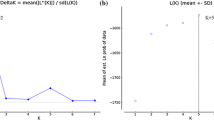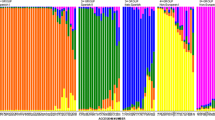Abstract
Genetic diversity of Melampsora larici-epitea leaf rust from three cultivated stands of the willow Salix viminalis was studied using AFLP polymorphisms at 60 loci. One population was located in Northern Ireland and two in Sweden. Analysis of molecular variance (AMOVA) showed that most of the genetic variation was distributed on a fine scale within the field in all populations. Both Swedish populations displayed a very high genotypic diversity (normalized Shannon's indices of 0.95 and 1.00) and random association among loci. These results suggested that sexual reproduction had an important influence on the Swedish populations. The occurence of the alternate host (larch) adjacent to one of the Swedish rust populations did not affect the genetic diversity. However, severe rust attacks started earlier in the season in this population. The M. larici-epitea population in Northern Ireland was characterized by a low genotypic diversity (normalized Shannon's index = 0.54) and non-random association among loci was indicated by test of multilocus association and by pairwise tests among loci. These results suggested that asexual reproduction had a major effect on the genetic structure of this population, probably because of the overwintering of asexual spores and/or a population bottleneck associated with the annual sexual phase.
Similar content being viewed by others
References
Agapow PM and Burt A (2000) MultiLocus 1.2. Dept of Biology, Imperial College, Silwood Park, Ascot, UK. http://www.bio.ic.ac.uk/evolve/software/multilocus/
Armstrong J, Gibbs A, Peakall R and Weiller G (1996) The Rapdistance Package, Version 1.04. Australian National University, Canberra
Aylor DE (1990) The role of intermittant wind in the dispersal of fungal pathogens. Annual Reviewof Phytopathology 28: 73–92
Brown AHD (1975) Sample sizes required to detect linkage disequilibrium between two or three loci. Theoretical Population Biology 8: 184–201
Burdon JJ and Roelfs AP (1985) The effect of sexual and asexual reproduction on the isozyme structure of Puccinia graminis. Phytopathology 75: 1068–1073
Chen XM, Line RF and Leung H (1993) Relationship between virulence variation and DNA polymorphism in Puccinia striiformis. Phytopathology 83: 1489–1497
Dawson WM and McCracken AR (1994) Effect of Melampsora rust on the growth and development of Salix burjatica ‘Korso’ in Northern Ireland. European Journal of Forest Pathology 24: 32–39
Excoffier L, Smouse PE and Quattro JM (1992) Analysis of molecular variance inferred from metric distances amongDNA haplotypes: Application to human mitocondrial DNA restriction sites. Genetics 131: 479–491
Felsenstein J (1993) PHYLIP (Phylogeny Inference Package) version 3.5c. Distributed by the author. Department of Genetics, University of Washington, Seattle
Goodwin SB, Spielman L, Matuszak JM, Bergeron SN and Fry WE (1992) Clonal diversity and genetic differentiation of Phytophtora infestans populations in northern and central Mexico. Phytopathology 82: 955–961
Hartl DL and Clark AG (1989) Principles of Population Genetics, 2nd edn. Sinauer Associates, Sunderland, Massachusetts
Hedrick PW (1987) Genetic disequilibrium measures: proceed with caution. Genetics 117: 331–341
Hedrick PW (2000) Genetics of Populations, 2nd edn. Jones and Bartlett Publishers, Boston, 553 pp
Hsiang T, Huang J, Yang L, Cook S, ShenYand Richter KJ (2000) Occurence of Kabatina juniperi in Ontario and genetic analysis using RAPD markers. Canadian Journal of Plant Pathology 22: 79–88
Hudson RR (1994) Analytical results concerning linkage disequilibrium in models with genetic transformation and conjugation. Journal of Evolutionary Biology 7: 535–548
Kohli Y and Kohn L (1998) Random association among alleles in clonal populations of Sclerotinia sclerotiorum. Fungal Genetics and Biology 23: 139–149
Maynard Smith J, Smith NH, O'Rourke M and Spratt BG (1993) Howclonal are bacteria? Proceedings of the National Academy of Sciences of the USA 90: 4384–4388
McCracken AR, Dawson WM, Watson S and Allen CY (2000) Pathotype composition in Melampsora epitea populations occuring on willow (Salix) grown in mixed and monoculture plantations. European Journal of Plant Pathology 106: 879–886
Milgroom MG (1996) Recombination and the multilocus structure of fungal pathogens. Annual Review of Phytopathology 34: 457–477
Nagarajan S and Singh DV (1990) Long-distance dispersion of rust pathogens. Annual Reviewof Phytopathology 28: 139–153
Nei M and Li WH (1979) Mathematical model for studying genetic variation in terms of restriction endonucleases. Proceedings of the National Academy of Sciences of the USA 76: 5269–5273
Page RDM (1996) TREEVIEW: An application to display phylogenetic trees on personal computers. Computer Applications in the Biosciences 12: 357–358
Parker SR, Royle DJ and Hunter T (1993) Impact of Melampsora rust on yield of biomass willows. In: Abstracts of the 6th International Congress of Plant Pathology, Montreal, Canada, 28 July—6 August, 117p
Pei MH, Royle DJ and Hunter T (1993) Identity and host alternation of some willow rusts (Melampsora spp.) in England. Mycological Research 97(7): 845–851
Pei MH and Ruiz C (2000) AFLP evidence of the distinctive patterns of life-cycle in two forms of Melampsora rust on Salix viminalis. Mycological Research 104(8): 937–942
Roelfs AP (1985) Wheat and rye stem rust. In: Roelfs AP, Bushnell WR (eds) The Cereal Rusts, Vol II, Diseases, Distribution, Epidemiology, and Control. Academic Press, Orlando, Florida, USA
Roelfs AP (1986) Development and impact of regional cereal rust epidemics. In: Leonard KJ, Fry WE (eds) Plant Disease Epidemiology: Population Dynamics and Management (pp 129–150) Macmillan, New York
Saitou N and Nei M (1987) The neighbor-joining method: A new method for reconstructing phylogenetic trees. Molecular Biology and Evolution 4: 406–425
Samils B, Lagercrantz U, Lascoux M and Gullberg U (2001) Genetic structure of Melampsora epitea populations in Swedish Salix viminalis plantations. European Journal of Plant Pathology 107: 399–409
Sheldon AL (1969) Equitability indices: Dependance on the species count. Ecology 50: 466–467
Schneider S, Kueffer JM, Roessli D and Excoffier L (1997) Arlequin ver 1.1: A software for population genetic data analysis. Genetic and Biometry Laboratory, University of Geneva, Switzerland
Van Arsdel EP (1967) The nocturnal diffusion and transport of spores. Phytopathology 57: 1221–1229
Van de Peer Y and De Wachter R (1994) TREECON for Windows: A software package for the construction and drawing of evolutionary trees for the Microsoft Windows environment. Computer Applications in the Biosciences 10: 569–570
Verwijst T (1990) Clonal differences in the structure of a mixed stand of Salix viminalis in response to Melampsora and frost. Canadian Journal of Forest Research 20: 602–605
Vos P, Hogers MB, Reijans M, van de Lee T, Hornes M, Frijters A, Pot J, Peleman J, Kuiper M and Zabeau M(1995) AFLP:Anew technique for DNA fingerprinting. Nucleic Acids Research 23: 4407–4414
Yeh FC, Yang RC, Boyle T, Ye ZH and Mao JX (1997) POPGENE, the user-friendly shareware for population genetic analysis. Molecular Biology and Biotechnology Center, University of Alberta, Canada
Author information
Authors and Affiliations
Rights and permissions
About this article
Cite this article
Samils, B., Stepien, V., Lagercrantz, U. et al. Genetic Diversity in Relation to Sexual and Asexual Reproduction in Populations of Melampsora larici-epitea. European Journal of Plant Pathology 107, 871–881 (2001). https://doi.org/10.1023/A:1013121809990
Issue Date:
DOI: https://doi.org/10.1023/A:1013121809990




